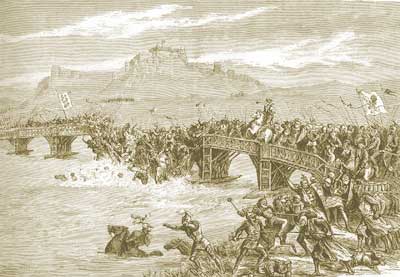1297 – Battle Of Stirling Bridge
Scotland was entirely submissive to England by 1296. Following English victories at Dunbar and Berwick, John Balliol had surrendered himself and was taken as a prisoner to England.
Edward I toured his new possession as far north as Elgin and removed the Stone of Destiny from Scone to take it back to London. He installed the Earl of Surrey, John de Warenne as Governor of Scotland and Hugh de Cressingham was made the treasurer.
Until now, William Wallace was considered by the English as merely an irritating criminal. Likewise, the self-important feudal hosts of Scotland gave him little credence.
When he joined his rebellious volunteers from the south-west with Andrew Murray’s north-eastern force, the relentless, successful strikes upon English installations forced Surrey to act. In late August he and Cressingham left Berwick with a large army of well trained and equipped soldiers to stamp out the rebellion.
On 10 September the English reached the Forth. To save time and therefore money, Cressingham chose to bring his vanguard across the river at the nearby wooden Stirling Bridge, rather than travel the further few miles to where the river was forded.
The army of Wallace and Murray had been waiting up on the Abbey Craig and on the morning of the 11th, once roughly half of Cressingham’s men had crossed the bridge, the rebels attacked. Those English on the north side were soon butchered and with the bridge blocked solid with corpses, Surrey and the second half of his army could not aid the first.
Amid huge English losses, Surrey turned and ran for Berwick.
Cressingham’s skin was used to make souvenirs. Although Scottish casualties were small, Murray was fatally wounded.
The beautiful Wallace Monument was built upon Abbey Craig.






